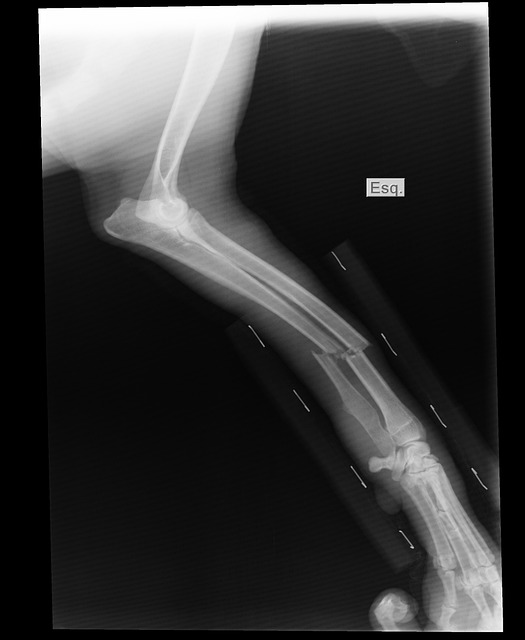TL;DR:
Contrast-enhanced radiography (CER) is an advanced imaging technique using contrast agents to improve accuracy and quality in X-ray and fluoroscopy. These agents highlight differences in tissue absorption of X-rays, enhancing visibility of structures like tumors, fractures, and vascular abnormalities. CER offers significant benefits such as early detection, treatment monitoring, and improved diagnostic accuracy. However, it faces challenges including adverse reactions, high costs, and patient eligibility restrictions. Future prospects include safer contrast media, advanced imaging techniques, and integration with analytics for even better outcomes.
“Unleashing enhanced visualization power, contrast agents revolutionize contrast-enhanced radiography and fluoroscopy. This article delves into the fundamentals of this technique, exploring how these substances bolster image quality. We uncover their pivotal role in specific procedures, from improving bone structure discernment to enhancing blood flow visibility.
Beyond mechanics, we analyze advantages, limitations, and future potential, providing a comprehensive guide to contrast-enhanced radiography‘s transformative impact on medical imaging.”
Understanding Contrast-Enhanced Radiography: Basics and Principles
Contrast-enhanced radiography (CER) is a powerful imaging technique that significantly improves the accuracy and quality of X-ray and fluoroscopy examinations. By introducing contrast agents, which are substances designed to interact with ionizing radiation, CER allows for better visualization of internal structures and abnormalities. These agents can be administered orally or intravenously, depending on the specific clinical need.
The basic principle behind CER is to exploit the differences in how various tissues absorb and scatter X-rays. Contrast agents have a higher radiopacity than surrounding tissue, leading to increased X-ray attenuation. This results in improved contrast between structures, making it easier for radiologists to detect and diagnose conditions such as tumors, fractures, or vascular abnormalities. The use of contrast agents enhances the sensitivity and specificity of radiographic examinations, ultimately improving patient care and diagnostic accuracy.
The Role of Contrast Agents in Improving Image Quality
Contrast agents play a pivotal role in enhancing the accuracy and detail of X-ray and fluoroscopy images, revolutionizing diagnostic capabilities in medical imaging. These agents, when introduced into the body, improve the contrast between different structures in the imaged area, making them more distinct and easily identifiable on radiographic films or digital sensors. This is particularly crucial in contrast-enhanced radiography (CER), where the use of specialized agents allows healthcare professionals to visualize blood vessels, tumors, and other abnormalities with unprecedented clarity.
By selectively absorbing or reflecting X-rays, contrast agents create a marked difference in radiation attenuation between normal tissues and pathologic structures. This results in high-contrast images that can reveal intricate details, enabling accurate diagnosis and treatment planning. Moreover, the ability to administer these agents systemically or regionally offers a non-invasive approach to enhance specific areas of interest, thereby improving the overall quality and interpretability of radiographic and fluoroscopic examinations.
Applications: Enhancing Specific X-ray and Fluoroscopy Procedures
Contrast agents play a pivotal role in enhancing the accuracy and effectiveness of specific X-ray and fluoroscopy procedures. In contrast-enhanced radiography (CER), these agents are administered intravenously or orally to highlight particular structures within the body, improving visibility and diagnostic precision. This is especially beneficial in evaluating blood vessels, lymph nodes, and organs like the kidneys, liver, and intestines.
For instance, CER can significantly aid in detecting abnormalities such as blockages, tumors, or inflammation. By providing a clear contrast between tissues and pathologies, radiologists can more accurately identify and localize these issues. Moreover, in fluoroscopy procedures, contrast agents help track the movement of fluids and gases in real-time, enabling better assessment of gastrointestinal tracts and urinary systems.
Advantages, Limitations, and Future Perspectives
Advantages, Limitations, and Future Perspectives
Contrast-enhanced radiography (CER) significantly improves the accuracy of X-ray and fluoroscopy procedures by enhancing the visualization of specific structures or regions of interest. The primary advantages lie in its ability to distinguish between various tissues, improve lesion detectability, and provide more detailed information about blood vessels and soft tissues. This is particularly beneficial in diagnosing conditions such as tumors, vascular malformations, and inflammatory diseases. CER also aids in monitoring treatment progress and identifying complications early on.
Despite these benefits, CER has certain limitations. One significant challenge is the potential for adverse reactions to the contrast media, ranging from mild allergic responses to more severe, life-threatening complications. Additionally, the use of contrast agents can be costly, and patient preparation is necessary to ensure optimal results. Furthermore, CER may not be suitable for all patients, particularly those with certain medical conditions or allergies. Future perspectives in this field include developing safer and more biocompatible contrast media, improving imaging techniques to reduce side effects, and integrating CER with advanced analytics for better diagnostic precision and patient outcomes.
Contrast agents play a pivotal role in enhancing the accuracy of X-ray and fluoroscopy procedures. By improving image quality, these agents enable healthcare professionals to detect subtle anatomical details and make more precise diagnoses. As technology advances, further research into contrast-enhanced radiography (CER) will likely lead to enhanced patient outcomes and expanded applications across various medical specialties. This innovative approach promises to revolutionize diagnostic imaging, ensuring better care for patients worldwide.
